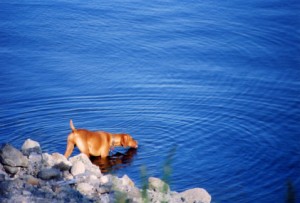Dogs with failing kidneys drink a lot of water and produce large quantities of urine.
Old or damaged kidneys don’t eliminate all of the body’s waste products and cannot concentrate urine very well.
When is this likely to happen in my dog?
Chronic kidney failure is the result of ageing; it is simply a “wearing out” process.
 Small dogs show signs from 10 years of age. Larger breed dogs’ kidneys may fail as early as 7 years of age. In some breeds there is a genetic predisposition to kidney failure.
Small dogs show signs from 10 years of age. Larger breed dogs’ kidneys may fail as early as 7 years of age. In some breeds there is a genetic predisposition to kidney failure.
What do I see if my dog’s kidneys are failing?
Dogs with kidney failure produce large volumes of dilute urine. This increases thirst in an effort to overcome dehydration.
As waste products build up in the blood they lose their appetite, are depressed, vomit, and have very bad breath. Ulcers form in the mouth. These signs of advanced kidney failure are called uraemia.
How is chronic kidney failure diagnosed?
- Blood tests for the body’s waste products, urea and creatinine
- Urine tests for concentrating and filtering ability, and to find infection
Can we treat kidney failure?
In some cases the kidneys are so worn out they cannot be revived.
With early diagnosis and appropriate treatment many dogs survive for many months or even years.
Treatment occurs in two phases. The first phase is to flush out the toxins with large quantities of intravenous fluids. Fluid therapy, also known as a drip, also replaces lost electrolytes, especially potassium. Drugs to control vomiting and diarrhea, and to treat infection are given as necessary.
The second phase of treatment reduces the kidneys’ workload by reducing dietary protein. This keeps toxic by-products of protein digestion as low as possible and makes your dog feel better. A special kidney or renal diet is the easiest and most effective way of doing this.
